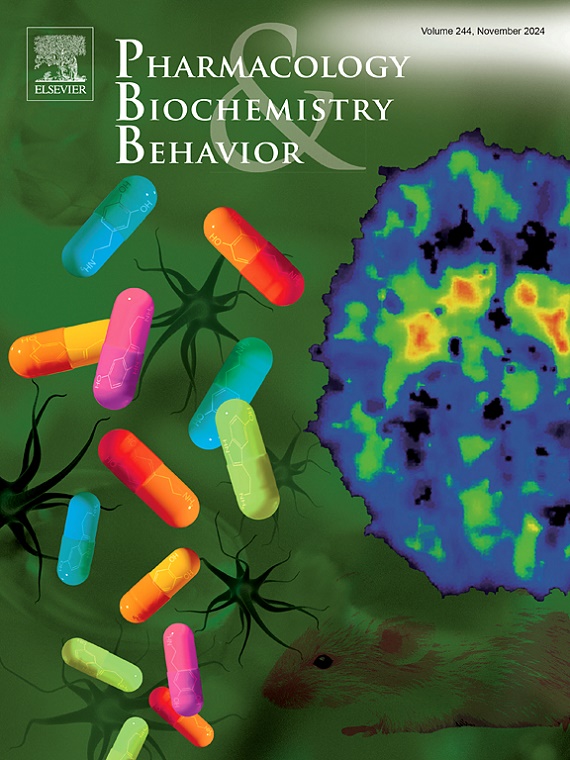产后丙酸暴露破坏大鼠海马agmatine稳态,导致自闭症谱系障碍样表型的社会缺陷和认知障碍
IF 3.3
3区 心理学
Q1 BEHAVIORAL SCIENCES
引用次数: 0
摘要
自闭症谱系障碍(ASD)是一种复杂的神经发育疾病,其特征是一系列症状,包括社交障碍和认知缺陷。虽然ASD的确切发病机制尚不清楚,但最近的临床研究结果表明,自闭症患者体内的生物源胺胍水平下降。本研究旨在探讨出生后丙酸(PPA)暴露对雄性大鼠幼鼠海马agmatine稳态的影响,并探索以agmatine为生物学靶点的ASD治疗干预新方法。PPA通常用于ASD的实验模型,因为它能够诱导社会缺陷、认知障碍和刻板行为,这些与ASD的关键特征非常相似。通过PND-21双侧海马内通路给药PPA(每侧25 μg/0.25 μl),模拟ASD表型及其对内源性agmatinergic系统的影响。还研究了胍丁氨酸处理及其内源调控对asd样表型的影响。行为评估显示,PPA暴露降低了社交能力和社会偏好,导致Morris水迷宫的学习和记忆障碍,升高+迷宫的焦虑样行为增加,孔板测试的探索行为减少。神经化学分析显示,海马体内的agmatinase浓度下降,其降解酶agmatinase增加。PPA处理改变了GABA、谷氨酸、TNF-α、IL-6、BDNF的含量,还导致海马内星形胶质细胞增生和神经毒性增加。慢性胍丁氨酸治疗及其内源性调节改善了PPA暴露引起的行为和生化破坏。本研究强调了海马agmatinergine通路在ASD发病机制中的关键作用,将agmatine定位为ASD治疗的有希望的治疗靶点。本文章由计算机程序翻译,如有差异,请以英文原文为准。
Postnatal propionic acid exposure disrupts hippocampal agmatine homeostasis leading to social deficits and cognitive impairment in autism spectrum disorder-like phenotype in rats
Autism Spectrum Disorder (ASD) is a complex neurodevelopmental condition characterized by a range of symptoms including impaired social interaction and cognitive deficits. Although the exact pathogenesis of ASD is not well established, recent clinical findings suggest a decline in levels of biogenic amine agmatine in autistic patients. The present study was designed to investigate the impact of postnatal propionic acid (PPA) exposure on hippocampal agmatine homeostasis in male rat pups and to explore a new therapeutic intervention for ASD using agmatine as a biological target. PPA is commonly used in experimental models of ASD due to its ability to induce social deficits, cognitive impairments, and stereotyped behaviors, which closely resemble key characteristics of ASD. Male rat pups were administered with PPA via the intrahippocampal route bilaterally (25 μg/0.25 μl per side) on PND-21 to simulate the ASD phenotype, and its subsequent effect on the endogenous agmatinergic system. The influence of agmatine treatment and its endogenous modulation on ASD-like phenotypes was also investigated. Behavioral assessments revealed that PPA exposure reduced sociability and social preference, caused learning and memory impairment in the Morris water maze, increased anxiety-like behavior in the elevated plus maze, and reduced exploratory behavior in the hole board test. Neurochemical analyses showed a decrease in agmatine concentration and an increase in its degrading enzyme agmatinase in the hippocampus. PPA treatment altered the content of GABA, glutamate, TNF-α, IL-6, BDNF, and also resulted in increased astrogliosis and neurotoxicity within the hippocampus. Chronic agmatine treatment and its endogenous modulation ameliorated the behavioral and biochemical disruptions induced by PPA exposure. This study highlights the critical role of hippocampal agmatinergic pathway in the etiopathogenesis of ASD, positioning agmatine as a promising therapeutic target for its treatment.
求助全文
通过发布文献求助,成功后即可免费获取论文全文。
去求助
来源期刊
CiteScore
6.40
自引率
2.80%
发文量
122
审稿时长
38 days
期刊介绍:
Pharmacology Biochemistry & Behavior publishes original reports in the areas of pharmacology and biochemistry in which the primary emphasis and theoretical context are behavioral. Contributions may involve clinical, preclinical, or basic research. Purely biochemical or toxicology studies will not be published. Papers describing the behavioral effects of novel drugs in models of psychiatric, neurological and cognitive disorders, and central pain must include a positive control unless the paper is on a disease where such a drug is not available yet. Papers focusing on physiological processes (e.g., peripheral pain mechanisms, body temperature regulation, seizure activity) are not accepted as we would like to retain the focus of Pharmacology Biochemistry & Behavior on behavior and its interaction with the biochemistry and neurochemistry of the central nervous system. Papers describing the effects of plant materials are generally not considered, unless the active ingredients are studied, the extraction method is well described, the doses tested are known, and clear and definite experimental evidence on the mechanism of action of the active ingredients is provided.

 求助内容:
求助内容: 应助结果提醒方式:
应助结果提醒方式:


